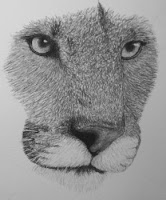Most animal artists I have read about say the eyes are the single most important part of an animal drawing. Many, including myself, begin each drawing with the eyes. That way, if they do not turn out right, it's easy to start over. The eyes are not just the organ of vision, they also contain a lot of the expression. So to get a good drawing, it is essential to get the eyes right.

Different types of animals have different types of eyes. Look at the predator eyes of a cat and a bird of prey. Then look at the eyes of a rabbit or a deer. They are all fundamentally different. Predators have eyes that look forward, while prey eyes look to the sides. The pupils must be positioned so the animal appears to be looking in the direction you want. If the head is not viewed straight-on, one eye will be partially hidden and foreshortened (in the case of an animal with forward-facing eyes). The pupil may not be in the same relative position as in the other eye because of this. Sometimes the shape of the cornea will distort the view of the pupil. Be sure to incorporate this - don't necessarily give your pupils a hard edge.

Don't forget the glint in the eye. The glint is very important for adding that element of vitality to a drawing. Since the cornea which reflects the light is round, try to show this in the glint (unless the glint is small). In close-up drawings of eyes, be particularly detailed. Sometimes you can actually see the surroundings reflected in the eye. Also give some texture to the iris if the eye is big in your drawing. The iris is like a muscle that contracts and relaxes to change the size of the pupil. Make it radiate from the center.

The tear duct is often overlooked. It is a simple little buldge at the inner corner. Depending on the direction of the light, you may have to add a little highlight on it. Lower eyelids often have a thin highlight as well. Upper lids are often covered in short fur and have eyelashes. Don't forget the shadow from the upper lid and eyebrow area.

This is the beginning of the cougar drawing. I am pleased with how this eye came out. I am starting to use the 6B charcoal pencil more and more because I like its darkness and maleability. I blended each part of the eye with a tortillon, then added the highlight to the lower lid with the kneaded eraser formed to a wedge and pulled. I started adding the fur with the 4B, but more on that in another tip to come.
If an eye is small, I will use a hard pencil (H or 2H) and blend for the iris. It's easier for me to get into those tiny areas.
 Now, that being said, from some angles and in some poses, parts of the fur may appear to be going the wrong way. This is where the fur is lifted or twisted by the muscles underneath or because of the perspective. Take, for example, my koala. In the dark areas on the right arm, the fur has been lifted up and casts a dark shadow. It appears to flow from the base UP to meet with the fur above it. In my cat drawing, the chest fur goes in all sorts of directions. It is essential to incorporate these variations or the drawing will not look real.
Now, that being said, from some angles and in some poses, parts of the fur may appear to be going the wrong way. This is where the fur is lifted or twisted by the muscles underneath or because of the perspective. Take, for example, my koala. In the dark areas on the right arm, the fur has been lifted up and casts a dark shadow. It appears to flow from the base UP to meet with the fur above it. In my cat drawing, the chest fur goes in all sorts of directions. It is essential to incorporate these variations or the drawing will not look real.








